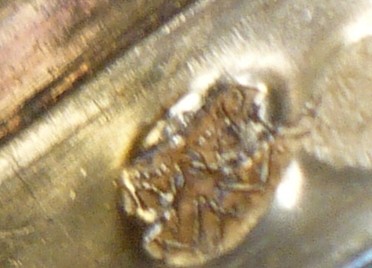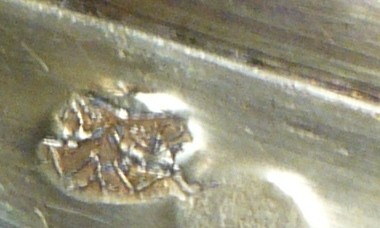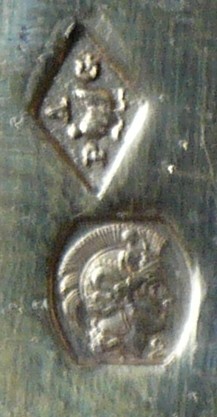Hi,
What you call a bigorne mark under your crowned fleur-the-Lys, is it a genuine counter-mark?
Bigorne; to discourage hallmarking fraud and deter the illegal practice of transposing marks from one to another, a system to counter-mark each hallmark was adopted. The process utilized a special insect-engraved anvil, called a bigorne. The patterns engraved into the anvil depicted zigzag rows of different insects, and items to be hallmarked were placed on top of them. When the item was stamped with a hallmark, the reverse side was impressed with the insect patterns from the anvil, leaving a counter-mark. These counter-mark insect impressions are often difficult to recognize because the numerous leg and body patterns are so closely arranged. This security method of counter- marking was used from 1818 until 1984
For comparison an image of a bigorne reverse site Minerva head 1883-1973 with number 2 under its chin to indicate minimum 800/1000 fineness. Indeed number 1 should indicate minimum 950/1000 fineness.


 The domestic French silver hallmarks 1838-1973
The domestic French silver hallmarks 1838-1973, the question mark (?) indicates the presence of an assay office symbol, number, or letter to indicate the RAO (Regional Assay Office)

Tardy’s book, International Hallmarks on Silver is a good source for a quick reference but for French silver (hall) marks, one of the most complex you need better reference books often very expensive, hard to get literature about French (hall)marks and maker’s mark.
You ask me to point to some examples of the crab mark in combination with pseudo marks. If you take some time to browse the well known online auction’s sites you might find descriptions like; with old French charge/discharge Marks, unknown maker’s mark and later added crab mark. Often those marks make no sense and are not mentioned in the known reference sources. We call them fantasy marks, part of the decoration and sometimes pseudo/fake marks to deceive. Often these objects with those spurious marks are made late 19th-early 20th century but are still made today. And I believe you have showed us one.
Reference/Gratitude: World Hallmarks Volume I Europe 19th to 21st centuries.
Oel.






